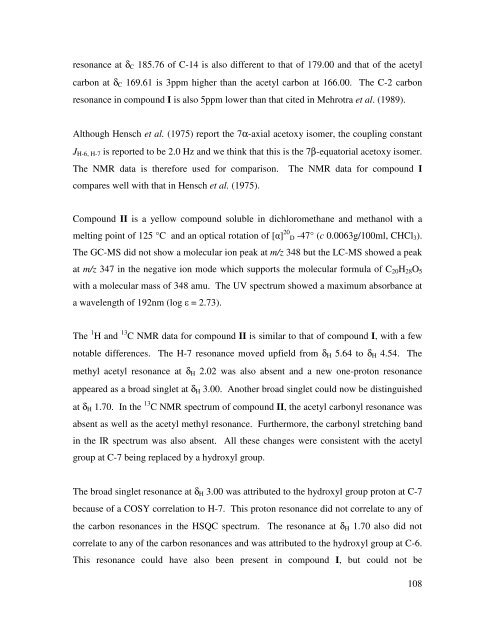university of kwazulu-natal faculty of science and agriculture school ...
university of kwazulu-natal faculty of science and agriculture school ...
university of kwazulu-natal faculty of science and agriculture school ...
Create successful ePaper yourself
Turn your PDF publications into a flip-book with our unique Google optimized e-Paper software.
esonance at δC 185.76 <strong>of</strong> C-14 is also different to that <strong>of</strong> 179.00 <strong>and</strong> that <strong>of</strong> the acetyl<br />
carbon at δC 169.61 is 3ppm higher than the acetyl carbon at 166.00. The C-2 carbon<br />
resonance in compound I is also 5ppm lower than that cited in Mehrotra et al. (1989).<br />
Although Hensch et al. (1975) report the 7α-axial acetoxy isomer, the coupling constant<br />
JH-6, H-7 is reported to be 2.0 Hz <strong>and</strong> we think that this is the 7β-equatorial acetoxy isomer.<br />
The NMR data is therefore used for comparison. The NMR data for compound I<br />
compares well with that in Hensch et al. (1975).<br />
Compound II is a yellow compound soluble in dichloromethane <strong>and</strong> methanol with a<br />
melting point <strong>of</strong> 125 °C <strong>and</strong> an optical rotation <strong>of</strong> [α] 20 D -47° (c 0.0063g/100ml, CHCl3).<br />
The GC-MS did not show a molecular ion peak at m/z 348 but the LC-MS showed a peak<br />
at m/z 347 in the negative ion mode which supports the molecular formula <strong>of</strong> C20H28O5<br />
with a molecular mass <strong>of</strong> 348 amu. The UV spectrum showed a maximum absorbance at<br />
a wavelength <strong>of</strong> 192nm (log ε = 2.73).<br />
The 1 H <strong>and</strong> 13 C NMR data for compound II is similar to that <strong>of</strong> compound I, with a few<br />
notable differences. The H-7 resonance moved upfield from δH 5.64 to δH 4.54. The<br />
methyl acetyl resonance at δH 2.02 was also absent <strong>and</strong> a new one-proton resonance<br />
appeared as a broad singlet at δH 3.00. Another broad singlet could now be distinguished<br />
at δH 1.70. In the 13 C NMR spectrum <strong>of</strong> compound II, the acetyl carbonyl resonance was<br />
absent as well as the acetyl methyl resonance. Furthermore, the carbonyl stretching b<strong>and</strong><br />
in the IR spectrum was also absent. All these changes were consistent with the acetyl<br />
group at C-7 being replaced by a hydroxyl group.<br />
The broad singlet resonance at δH 3.00 was attributed to the hydroxyl group proton at C-7<br />
because <strong>of</strong> a COSY correlation to H-7. This proton resonance did not correlate to any <strong>of</strong><br />
the carbon resonances in the HSQC spectrum. The resonance at δH 1.70 also did not<br />
correlate to any <strong>of</strong> the carbon resonances <strong>and</strong> was attributed to the hydroxyl group at C-6.<br />
This resonance could have also been present in compound I, but could not be<br />
108

















